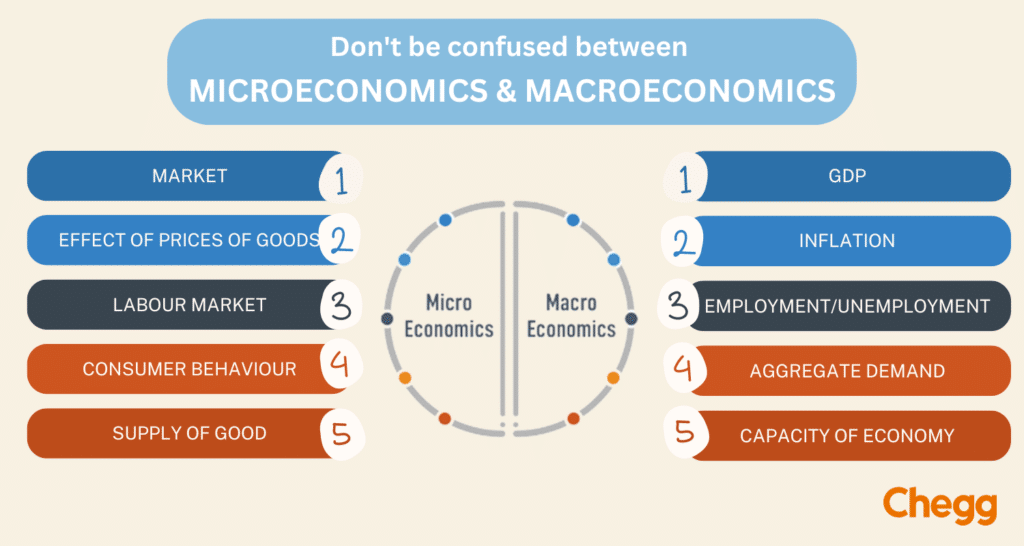

Quick Summary
Economics is a branch of knowledge that examines a nation’s financial structure and the various factors that influence it. As a social science, it focuses on producing, consuming, and distributing goods and services. The field of economics is divided into two primary branches: Microeconomics and Macroeconomics. Adam Smith (1723-1790), widely regarded as the “father of economics,” laid the foundation for understanding these concepts through his pioneering work.
While Microeconomics studies the individual units of a country’s economy, Macroeconomics deals with the entire economy of a country. These two branches of economics explain how economies work, ranging from the economy of just an individual to the economy of an entire country.
This article will focus on understanding the two concepts—microeconomics and Macroeconomics—and their major differences.

| Basis | Microeconomics | Macroeconomics |
| Meaning | Microeconomics is the study of individual units of the economy of a nation. | Macroeconomics studies the aggregate variables of the economy of a nation. |
| Area of Study | The area of study of Microeconomics includes the particular market segment of an economy. | Microeconomics deals with multiple issues such as Demand and Supply, Product pricing, Factor pricing, Production, Consumption, Economic welfare |
| Deals with | Macroeconomics deals with several issues such as National Income, Employment Distribution, General price level. | Macroeconomics deals with several issues such as National Income, Employment Distribution, and General price level. |
| Area of Application | Applied to internal issues. | Applied to external and environmental issues. |
| Concept | Narrow | Wide |
| Scope | Theory of product pricing, Theory of factor pricing, Theory of economic welfare | Theory of economic growth and development, Theory of money, Theory of national income, Theory of international trade, Theory of employment, Theory of general price level |
| Importance | Helps in the determination of prices of products or commodities, along with the pricing of factors of production in an economy. | Helps in dealing with critical issues like inflation, deflation, reflation, unemployment, and poverty in an economy as a whole. |
| Limitations | The study is based on presuppositions. | The study incorporates the misconception of composition. |
Before heading towards the difference between Microeconomics and Macroeconomics, let us first understand each branch of economics separately.
Microeconomics is the study of the Microelements of the economy. These Microelements can be a single individual, a household, or a business firm. The way these elements maintain their economy, that is, allocate their scarce resources and their interaction with other elements is studied under Microeconomics.
Microeconomics generally analyses the market and determines the prices of goods and services. It studies how individuals or firms allocate their resources, and how it affects the utilization and distribution of their resources.
Macroeconomics is a study of the macro elements in economics. It is the aggregate study of the economy of a nation. Macroeconomics deals with the performance, structure, behavior, and decision-making of the entire economy as a whole.
It analyses the markets, businesses, industries, and governments on an overall basis. The government policies and the factors influencing the economy of a nation are covered under the scope of Macroeconomics.

Microeconomics and Macroeconomics are two distinct branches of economics. While Microeconomics focuses on the economic behaviour of individuals and firms in the market, Macroeconomics focuses on the overall performance of the economy as a whole. The two branches of economics are closely related and interact with each other.
In Microeconomics, the behaviour of individual consumers and firms is studied to determine how they interact in the market to produce and allocate resources. This economic behaviour is then used to analyse the overall performance of the economy. For example, the demand and supply of a certain good can be studied to understand how it affects the overall price level.

On the other hand, Macroeconomics focuses on the aggregate economic performance of a nation. It examines the factors that affect the overall economic performance such as GDP, inflation, unemployment, and trade balance. It also studies the effect of fiscal and monetary policies on the economy.
The two branches of economics interact with each other. Microeconomic decisions of households and firms affect the Macroeconomic performance of the economy. For example, the decisions of households to consume or save can affect the overall level of economic growth. Similarly, the decisions of firms to invest or not can affect the overall level of investment in an economy.
Both Microeconomics and Macroeconomics hold importance in their area of application.
There is both practical and theoretical importance to Microeconomics. The primary significance is that it helps in determining the prices of commodities in an economy. Microeconomics plays a vital role in formulating policies that help enhance production efficiency and result in greater economic welfare. It allows us to determine the working of a capitalist economy and the equilibrium price of a free economy.
As Macroeconomics studies the entire economy of a country as a whole, it helps in understanding the functioning of a complex modern economic system. It allows determining the level of national income and employment with the help of aggregate demand and supply. Macroeconomics analyses the fluctuations in business activities and helps in maintaining a stable price level.
Let us now understand the scope of Microeconomics and Macroeconomics.
The scope of Microeconomics mainly consists of three theories –
The scope of Macroeconomics includes the following theories –
The differences between Micro and Macroeconomics can also be understood based on the constraints faced by it. Here are the limitations of Microeconomics and Macroeconomics:
Economics is indeed a professing career option as the knowledge imparted in this study contributes greatly to a nation’s Microeconomics and Macroeconomic model. Microeconomics focuses on individual markets, while Macroeconomics focuses on whole economies. The main difference between Microeconomics and Macroeconomics is the scale.
Microeconomics studies the behaviour of individual households and firms in making decisions on the allocation of limited resources. Another way to phrase this is to say that Microeconomics studies markets.
On the other hand, Macroeconomics is generally focused on countrywide or global economics. Its studies involve total economic activity, dealing with growth, inflation, and unemployment. In this article, we have discussed the key difference between Microeconomics and Macroeconomics. The primary comparison between Micro vs Macro has been made above which can help you get a clear understanding of both branches of economics. As you read the subjects in greater depth, there will be a lot more to analyze.
Microeconomics and macroeconomics offer diverse career paths across various industries. While microeconomics focuses on individual businesses and consumer behavior, macroeconomics deals with broader economic factors like national income, inflation, and fiscal policies.
Career Opportunities in Microeconomics
Career Opportunities in Macroeconomics
Both fields offer excellent career prospects in government agencies, financial institutions, multinational corporations, and research organizations.
Microeconomics studies topics such as supply and demand, cost and production, pricing, market structures, and consumer behaviour.
Macroeconomics looks at national and international economic trends such as unemployment, inflation, economic growth, and monetary and fiscal policy.
Microeconomics focuses on the small details, like how people spend their money or how companies decide on prices. It’s about individual choices and specific markets.
Macroeconomics looks at the big picture, like how the entire economy is doing, what causes prices to rise, or how many people have jobs. It’s about understanding the economy of a whole country or even the world.
Limitations of Microeconomics – Assumes people always make logical choices, Ignore other changing factors, Focus only on small parts of the economy, and Often don’t consider changes over time.
Limitations of Macroeconomics – Looks at the big picture, missing details, Hard to predict due to many influencing factors, Policies can have unexpected results, Good data can be hard to find.
Significance of Microeconomics – Understands how people and businesses decide what to buy and sell, explains how prices are set by supply and demand, shows how people maximize satisfaction, helps companies price products and manage costs.
Significance of Macroeconomics – Guides tax and spending decisions, analyzes growth and inflation, aims to control inflation and reduce unemployment, and understands interactions between countries’ economies.
Adam Smith is often regarded as the father of economics as a whole, but Alfred Marshall is specifically considered the father of Microeconomics. His book Principles of Economics (1890) introduced key concepts such as supply and demand, consumer surplus, and elasticity, which form the foundation of modern microeconomic theory.

Authored by, Amay Mathur | Senior Editor




Amay Mathur is a business news reporter at Chegg.com. He previously worked for PCMag, Business Insider, The Messenger, and ZDNET as a reporter and copyeditor. His areas of coverage encompass tech, business, strategy, finance, and even space. He is a Columbia University graduate.
Editor's Recommendations
Chegg India does not ask for money to offer any opportunity with the company. We request you to be vigilant before sharing your personal and financial information with any third party. Beware of fraudulent activities claiming affiliation with our company and promising monetary rewards or benefits. Chegg India shall not be responsible for any losses resulting from such activities.
Chegg India does not ask for money to offer any opportunity with the company. We request you to be vigilant before sharing your personal and financial information with any third party. Beware of fraudulent activities claiming affiliation with our company and promising monetary rewards or benefits. Chegg India shall not be responsible for any losses resulting from such activities.